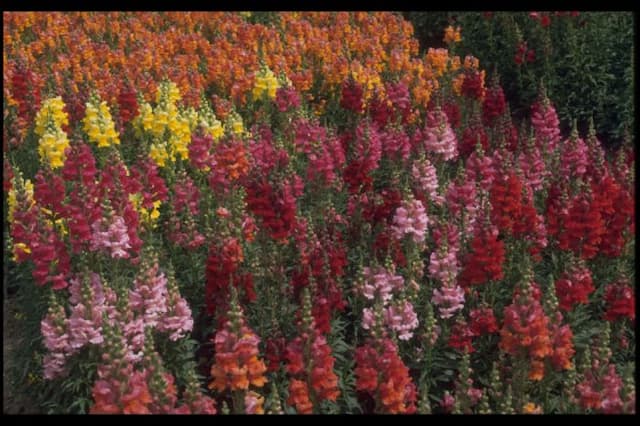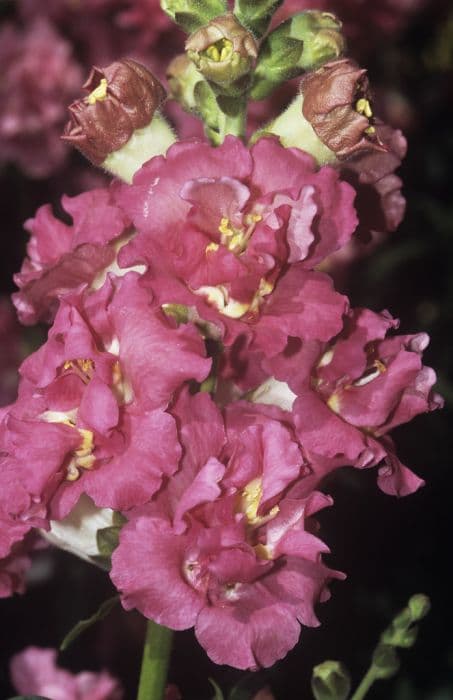Shrubby Veronica Hebe topiaria

ABOUT
Hebe topiaria, commonly referred to simply as hebe, is a shrub that is prized for its neat, dome-shaped form, which resembles a carefully sculpted topiary. The leaves of this evergreen are small, glossy, and spear-shaped, presenting a lush appearance all year round. Its tightly packed foliage, which has a fine, crisp texture, ranges from a deep green to gray-green color, giving the plant a somewhat formal look. During the summer season, the hebe may produce blooms. The flowers are delicate, held in small, dense racemes that emerge at the tips of the branches. Typically, the blooms are a soft shade of lilac or pale violet, adding a subtle hint of color against the greenery. This plant often has a dense, bushy growth habit, making it an excellent choice for hedges, borders, or as a standalone specimen in a garden for its structured aesthetic. Overall, the hebe's appearance is characterized by its compact shape, dense foliage, and, when in bloom, delicate flowers that enhance its visual interest.
About this plant
 Names
NamesFamily
Plantaginaceae.
Synonyms
Shrubby Veronica, Hebe.
Common names
Hebe topiaria
 Toxicity
ToxicityTo humans
Hebe topiaria, commonly known as simply Hebe, is not widely reported to be toxic to humans. However, as with many plants, individual sensitivities can vary, and it is generally advisable to avoid ingesting plants that are not commonly recognized as edible. In the rare event of a reaction or significant ingestion, symptoms could potentially include gastrointestinal discomfort, such as nausea, vomiting, or diarrhea. It is always important to contact a medical professional or poison control center if any adverse effects are observed following the ingestion of plant material.
To pets
Hebe topiaria, referred to as Hebe, is not commonly listed as a toxic plant to pets such as dogs and cats. Nevertheless, ingestion of non-food items, including ornamental plants, can sometimes cause gastrointestinal upset in animals. If a pet does consume parts of the Hebe, they might experience mild symptoms including vomiting or diarrhea. If these or other concerning symptoms occur, it is recommended to consult a veterinarian. Always exercise caution and prevent pets from consuming plants not meant for their consumption.
 Characteristics
CharacteristicsLife cycle
Perennials
Foliage type
Evergreen
Color of leaves
Green
Flower color
White
Height
3 feet (0.91 meters)
Spread
3 feet (0.91 meters)
Plant type
Shrub
Hardiness zones
8
Native area
New Zealand
Benefits
 General Benefits
General Benefits- Low-maintenance: Hebe topiaria requires minimal care, making it a convenient choice for busy gardeners.
- Drought-tolerant: Once established, it can survive with limited water, suitable for xeriscaping.
- Visual Appeal: Offers year-round foliage interest and structure to gardens.
- Attracts Wildlife: Flowers attract bees and butterflies, promoting biodiversity.
- Evergreen: Retains its leaves throughout the year, providing constant greenery.
- Compact Size: Its small stature makes it suitable for smaller gardens or as a border plant.
- Resistant to Deer: Typically not preferred by deer, helping to reduce garden damage.
- Versatile Usage: Can be used in pots, as a specimen plant, or as part of mixed borders.
- Soil Flexibility: Adapts to a range of soil types, assuming they have good drainage.
- Wind Resistant: Its robust nature allows it to survive in exposed, windy conditions.
 Medical Properties
Medical PropertiesThis plant is not used for medical purposes.
 Air-purifying Qualities
Air-purifying QualitiesThis plant is not specifically known for air purifying qualities.
 Other Uses
Other Uses- Miniature Hedge Sculpture: Hebe topiaria can be meticulously pruned to create small-scale hedge sculptures in a fairy or miniature garden.
- Photography Prop: The dense and neat foliage of Hebe topiaria makes it a suitable backdrop or feature for plant photography, especially macro shots.
- Education Tool: Because of its distinct form, Hebe topiaria can be used to teach basic principles of topiary and plant training to students and gardening enthusiasts.
- Container Gardening Accent: With its compact shape, Hebe topiaria works well in container gardens as a focal point without overwhelming other plants.
- Film and Theatre Sets: The plant's unique appearance makes it a good candidate for use in set design, providing greenery on the stage or on film sets.
- Themed Landscaping: Its formal look suits historical or colonial-themed garden landscapes, complementing the architectural styles with its manicured appearance.
- Culinary Presentation: Small sprigs of Hebe topiaria may be used as a garnish or decorative element in upscale culinary presentations due to its attractive form.
- Erosion Control: Hebe topiaria can be planted on slopes in moderate climates to help stabilize the soil and prevent erosion, due to its root structure.
- Garden Model Making: The plant can be used in creating garden models or dioramas due to its scale and ease of shaping.
- Ice Cream Presentation: For novelty, restaurants and caterers sometimes use small Hebe topiaria sprigs to add a green touch to the presentation of desserts like ice cream.
Interesting Facts
 Feng Shui
Feng ShuiThe Hebe is not used in Feng Shui practice.
 Zodiac Sign Compitability
Zodiac Sign CompitabilityThe Hebe is not used in astrology practice.
 Plant Symbolism
Plant Symbolism- Everlasting Youth: The genus name 'Hebe' originates from the Greek goddess of youth, signifying a connection to eternal youth and vigor.
- Unity: The symmetrical growth habit and the neatly shaped appearance of Hebe topiaria symbolize balance and harmony, often linked with unity and togetherness.
- Protection: Its dense foliage provides shelter, which can be interpreted as a symbol of protection and safety.
- Adaptation: Given the Hebe's ability to thrive in various conditions, it can represent adaptability and resilience in the face of change.
- New Beginnings: As an evergreen plant, it embodies renewal and fresh starts, signifying hope and new opportunities.
 Water
WaterThe Hebe topiaria, commonly known as Shrubby veronica, requires watering that ensures the soil remains moist but not waterlogged. It should be watered once a week with 1 gallon of water during the growing season. In hotter climates or during periods of drought, the frequency may increase to twice a week. During the winter months, reduce watering to every other week since the plant's water requirements decrease. Always check the top inch of the soil before watering; if it feels dry, it's time to water.
 Light
LightShrubby veronica thrives best in a spot where it can receive full sun to partial shade. An ideal location would provide it with at least 6 hours of sunlight daily, with some protection from intense afternoon sun. The plant can tolerate a range of light conditions, but consistent bright, indirect light will promote the healthiest growth.
 Temperature
TemperatureShrubby veronica performs best in temperatures between 50°F and 70°F, which are considered ideal conditions for the plant. It can withstand minimum temperatures down to around 20°F but should be protected from frost to avoid damage. The maximum temperature should not exceed 80°F for extended periods, as this can stress the plant.
 Pruning
PruningPrune Shrubby veronica to maintain its shape and encourage bushier growth. The best time to prune is in early spring before new growth begins. Remove dead or damaged branches and cut back up to one-third of the plant's size annually. Light pruning can also be done after the plant has flowered to keep it looking tidy.
 Cleaning
CleaningAs needed
 Soil
SoilHebe topiaria, commonly known as Shrubby Veronica, thrives in well-draining soil with a slightly acidic to neutral pH between 6.5 and 7.5. A good soil mix for this plant could include a blend of two parts peat moss or compost, one part perlite or sand to ensure proper drainage, and one part garden loam.
 Repotting
RepottingShrubby Veronica (Hebe topiaria) typically requires repotting every 2 to 3 years to refresh the soil and prevent root-bound conditions. It's best to repot this plant in the spring or early summer when it's in active growth.
 Humidity & Misting
Humidity & MistingShrubby Veronica (Hebe topiaria) prefers moderate humidity levels but is tolerant of a range of conditions and does not require high humidity. Ensuring good air circulation and avoiding excessively dry environments are beneficial.
 Suitable locations
Suitable locationsIndoor
Place Hebe topiaria in bright, indirect light with well-draining soil.
Outdoor
Hebe topiaria requires sunlight, well-drained soil, and protection from harsh wind.
Hardiness zone
8-10 USDA
 Life cycle
Life cycleHebe topiaria, commonly known as Shrubby Veronica, begins its life cycle with seed germination, which occurs when conditions are warm and moist. The seeds develop into seedlings, which then grow into juvenile plants with characteristic dense, rounded foliage. As it matures, the plant produces stems that become woody at the base, and its small, glossy, evergreen leaves form a distinctive mound-shaped habit. During summer months, Shrubby Veronica blossoms with small white or pale lilac flowers that attract pollinators, ensuring the production of seeds for the next generation. After flowering, the plant enters a period of dormancy, particularly in cooler climates, where it conserves energy for the next growing season. Over many years, Hebe topiaria may become woody and less vigorous, at which point gardeners may propagate from cuttings or replace the plant to maintain the garden's aesthetic.
 Propogation
PropogationPropogation time
Spring-summer
Propogation: The Hebe topiaria, commonly known as the Hebe or shrubby veronica, is generally propagated through semi-hardwood cuttings. The best time to take these cuttings is in the later part of summer when new growth has begun to mature and harden slightly. To propagate Hebe topiaria, a gardener would select healthy, non-flowering shoots and cut a 4 to 6 inch (about 10 to 15 cm) length, ensuring that several leaf nodes are included. The lower leaves should be removed, and the base of the cutting is then dipped in rooting hormone before being inserted into a well-draining soil mix. Maintaining a humid environment around the cutting by covering it with a plastic bag or placing it in a propagator helps to ensure success. The cutting should root in a few weeks, after which it can be gradually acclimated to normal growing conditions.





![Snapdragon [Pretty in Pink]](/_next/image?url=https%3A%2F%2Fplants-admin.emdemapps.com%2Fimages%2Fplants%2F%2Fimages%2F604b5cb3b5385.png&w=640&q=75)



